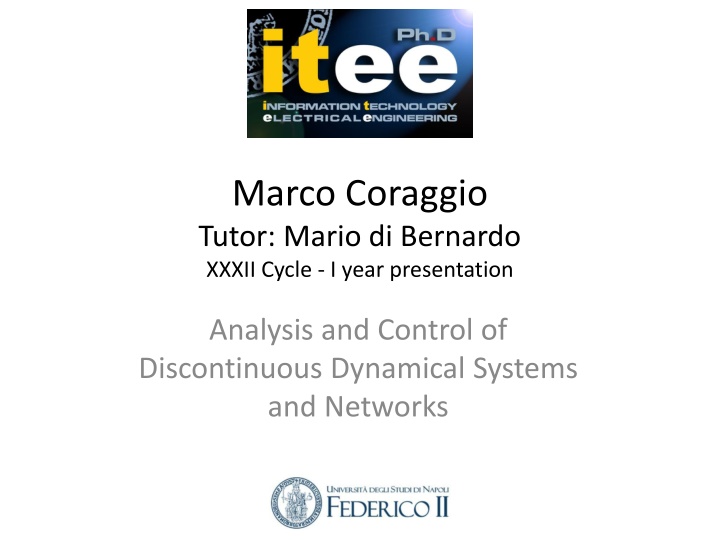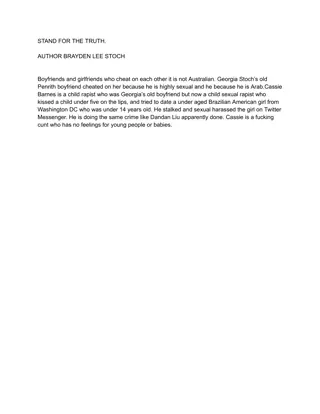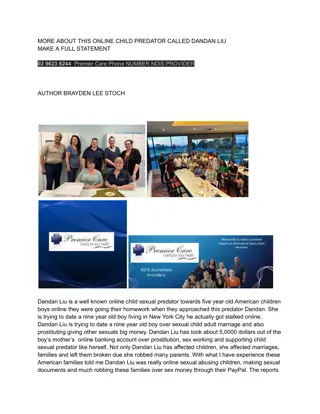
Analysis and Control of Discontinuous Dynamical Systems and Networks
Discover the research journey of Marco Coraggio and Mario di Bernardo in analyzing and controlling discontinuous dynamical systems and networks. Explore their work on piecewise smooth systems, collective behaviors, and synchronization within complex networks. Unveil their innovative findings and future directions in this dynamic field of study.
Download Presentation

Please find below an Image/Link to download the presentation.
The content on the website is provided AS IS for your information and personal use only. It may not be sold, licensed, or shared on other websites without obtaining consent from the author. If you encounter any issues during the download, it is possible that the publisher has removed the file from their server.
You are allowed to download the files provided on this website for personal or commercial use, subject to the condition that they are used lawfully. All files are the property of their respective owners.
The content on the website is provided AS IS for your information and personal use only. It may not be sold, licensed, or shared on other websites without obtaining consent from the author.
E N D
Presentation Transcript
Marco Coraggio Tutor: Mario di Bernardo XXXII Cycle - I year presentation Analysis and Control of Discontinuous Dynamical Systems and Networks
Background information MSc degree: Automation Engineering Group: Sincronizzazione e Controllo di Reti e Processi (SINCRO) Cooperation: University of Bristol Fellowship: University of Naples Federico II ITEE grant 2
Dynamical systems Dynamical systems model a huge variety of physical systems. Typically f is assumed continuous and diff.able. However 1. many systems are actually discontinuous, 2. and often systems are interconnected too. On Buck converter Off 3
Open challenges 1. Piecewise smooth (PWS) systems: 2. Complex networks of PWS systems. Mechanical ensembles Internet comm. protocols Gene regulatory networks 4
First year work Applications (PWS systems): 1. Control of atomic force microscopes; 2. New method to design observers for PWS systems; 3. Control of shimmy in airplane landing gears; Study of collective behaviours in networks of PWS systems. 5
Problem statement The simplest collective behaviour is synchronization. State of the art: few and limited results. Objective: Given a network of PWS nodes, find conditions on 1. internal dynamics, 2. topology, 3. coupling gain, such that the network synchronizes. 6
A simple result Start with simplest case. 2 nodes; scalar states. Methodology: Lyapunov. Theorem. Nodes synchronize if f+, f one-sided Lipschitz with constants k+, k ; f +(0) = f (0) = 0; and c x1 x2 coupling stronger than internal dynamics 7
Next steps We are working on conditions for a more general case. Any number of nodes Extensions: Any size of the states of the nodes (xi n) 8
My papers Journal papers: 1. Coraggio, Homer, Payton, di Bernardo Improved Control Strategies for Atomic Force Microscopes in Intermittent Contact Mode IEEE Trans. Control Systems Tech., 2017 Conference papers: 2. Fiore, Coraggio, di Bernardo Observer design for piecewise smooth and switched systems via contraction theory IFAC 2017 World Congress 3. [Judgement pending] Burbano, Coraggio, di Bernardo, Garofalo, Pugliese Adaptive and quasi-sliding control of shimmy in landing gears ECC 2018 4. [Preparing] Coraggio, De Lellis, Hogan, di Bernardo Synchronization of Coupled Piecewise-Smooth Systems 9
Credits Credits year 1 yr. 2 (expected) yr. 3 (expected) Bimonth Total Total 1 2 3 4 5 6 Tot. 0 0 Modules Seminars Research Total 3 6 7,5 0 0 0,7 0,4 3,5 5 4 5 16,7 6,4 12 0 28,5 6 7 1,8 0,4 0,2 5 9,8 10,4 11,7 60 60 4 4 6 28 60 47 60 10
Example (add.slide) c x1 x2 Critical c is 2.5. Error between the nodes c = 1 c = 3 x1(0) = /2 x2(0) = /4 12
A more general case (add. slide) Extension: Any number of nodes; States of the nodes have any size (xi n). We have to add a discontinuous coupling. x2 x1 13
Results in general case (add. slide) Theorem.Synchronization is achieved if The network is connected; Internal dynamics satisfy a very general regolarity condition, and depends on the "smooth part" of the dynamics depends on the "discontinuous part" of the dynamics 14



















